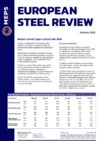EU cold heading steel prices rise for Q2 business
European steel buyers of cold heading quality (CHQ) rod must pay significantly more for their material, in the second quarter. Following the trend of other wire-related products, regional steel producers have secured substantial price hikes during their recent negotiations.
The European CHQ market has been exposed to the same cost pressures that have influenced all other steel products, in recent months. The outbreak of war in Ukraine was the catalyst for the spike in prices.
The military action is having both a direct and indirect impact on the market.
CHQ rod supply from Ukraine has ceased. Russian and Belarussian material is unavailable, due to the sanctions imposed by the European Union. Many purchasing managers, in Europe, report that this has caused supply shortages, in several products, such as nail wire.
European mills had to review their production schedules, owing to the rapid rise in their raw material expenditure. Furthermore, energy costs have surged, and remain at elevated levels, due to the crisis.
It is reported that several CHQ producers added energy cost-related clauses to their pricing mechanisms, in an attempt to maintain their existing profit margins. Alternatively, other mills have used the surge in their input expenditure as the main rationale to hike their basis prices.
Buyers claim that several steel manufacturers are only willing to commit to monthly prices, as opposed to their traditional quarterly agreements.
Some German and Benelux-based producers were late to finalise their pricing and delivery intentions for the second quarter. Buying from Spain was problematic, due to ongoing transport disruptions. A lack of UK buying options exists. Central European supply is limited, owing to the regional mills’ exposure to raw material deliveries from the east.
The current supply concerns, however, have been largely offset by the ongoing demand weakness in many CHQ-consuming segments.
Car-related activity remains at low levels, due to supply chain difficulties, including the ongoing lack of semiconductors. Other vital components, previously produced in Ukraine, are now in short supply. Some automotive production has been moved from Ukraine to neighbouring countries, such as Poland and the Czech Republic, on a temporary basis. This is to minimise any potential disruption to vehicle output.
Commodity price inflation is an increasing concern. Tightening monetary and fiscal policies are expected to significantly affect future consumption. This will negatively influence demand from most steel-using sectors. The risks of a recession, this year or in 2023, are growing, across the continent.

Source:
European Steel Review
The MEPS European Steel Review is an informative, concise and easy-to-use monthly publication, offering unique professional insight into European carbon steel prices.
Go to productRequest a free publication





